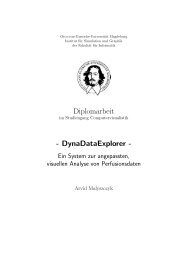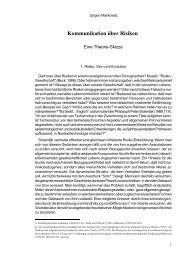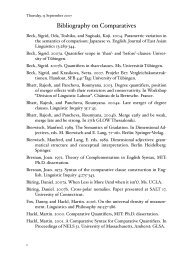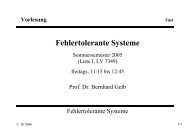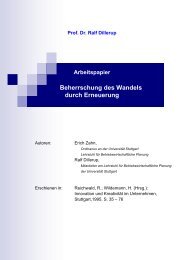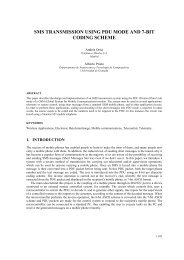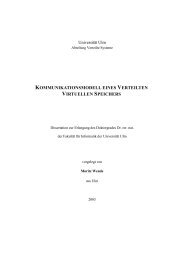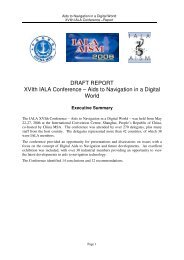Dr. Hanno Scharr
Dr. Hanno Scharr
Dr. Hanno Scharr
Create successful ePaper yourself
Turn your PDF publications into a flip-book with our unique Google optimized e-Paper software.
<strong>Dr</strong>. <strong>Hanno</strong> <strong>Scharr</strong><br />
Institute for Chemistry and Dynamics of the<br />
Geosphere (ICG), Institute III: Phytosphere<br />
Research Center Jülich GmbH<br />
52425 Jülich, Germany<br />
phone: +49 (0)2461-61-5701<br />
H.<strong>Scharr</strong>@fz-juelich.de<br />
Current position<br />
Research Associate (HGF-Nachwuchswissenschaftler)<br />
Date and place of birth<br />
Sep 10, 1969 in Heilbronn, Germany<br />
Nationality and Status<br />
German, married, 2 sons<br />
Education<br />
Ruprecht-Karls-University Heidelberg<br />
- Image Processing, 11/1996-05/2000<br />
Ph.D. (German <strong>Dr</strong>. rer. nat.) 05/2000<br />
Supervisors Prof. <strong>Dr</strong>. B. Jähne and Prof. <strong>Dr</strong>. G. Wittum<br />
- Physics, 10/1990 – 09/1996<br />
B.Sc. (German Vordiplom) 06/1992<br />
M.Sc. (German Diplom) 09/1996<br />
Supervisor Prof. <strong>Dr</strong>. B. Jähne<br />
- Sports and Sports Science, 10/1992-09/1999<br />
B.Sc. (German Zwischenprüfung) 06/1996<br />
Justinus-Kerner-Gymnasium Weinsberg<br />
- Abitur (Honours), 1989<br />
Professional Experience<br />
Senior Researcher at Intel Research, Santa Clara , USA, 08/2002 – 07/2003<br />
Research Associate (HGF-Nachwuchswissenschaftler) at Research Centre Jülich,<br />
Member of the Hermann von Helmholtz Association of National Research Centres<br />
(HGF), Jülich, Germany, since 08/2001 (paused for research stay at Intel)<br />
Research Associate at Interdisciplinary Center for Scientific Computing (IWR),<br />
Heidelberg University, Germany, 11/1999 – 07/2001<br />
Consulting as software engineer, Windows NT Application with MFC for Max-
Planck-Institute (MPI) for Nuclear Physics, Heidelberg, Germany 05/1998 – 06/1998<br />
Final year project (Diplomarbeit) at ABB Corporate Research Center, Heidelberg,<br />
Germany, 09/1995 – 08/1996<br />
Scientific assistant (Wissenschaftliche Hilfskraft) as system administrator at the<br />
Institute for Sports and Sports Science, Heidelberg University, Germany, 06/1995<br />
– 06/1996<br />
Consulting as software engineer for speech pattern recognition and databases at<br />
IBM Research Center, Heidelberg, Germany, 02/1994 – 06/1995<br />
Scholarship<br />
Graduate Scholarship, Center of Excellence (Graduiertenkolleg) ”Modeling and Scientific<br />
Computing in Mathematics and Natural Sciences”, at Interdisciplinary Center<br />
for Scientific Computing IWR, University of Heidelberg, 11/1996 – 10/1999<br />
Reviewing<br />
International Conference on Computer Vision and Pattern Recognition, CVPR<br />
2003, CVPR 2004<br />
IEEE Transactions on Image Processing<br />
IEEE Transactions on Pattern Analysis and Machine Intelligence<br />
Computing and Visualization in Science<br />
Other Activities<br />
Trainer and backstage manager at the children and youth circus ”Peperoni e.V.” in<br />
Heidelberg (up to 120 children, honorary), 1993 – 2002<br />
Carer of youth groups (up to 1200 children, during summer holidays, honorary,<br />
Gaffenberg Heilbronn and other Groups), 1989 – 1998<br />
2
Research Interests<br />
My research is focused on quantitative image and image sequence processing as an<br />
analysis tool for scientific, medical and industrial data.<br />
In typical applications detailed and accurate physical, biological, medical or tech-<br />
nical models of the observed objects are available. Unfortunately, in most cases<br />
acquired images do not directly reveal the object properties of interest. In addi-<br />
tion scientific, medical or industrial imaging often operates at the sensor sensitivity<br />
limit and thus the acquired data suffers from noise. Therefore the general prob-<br />
lem addressed in my research is parameter estimation – i.e. measurement of object<br />
properties – in corrupted or noisy multidimensional data.<br />
Theoretical basis of this are fast, robust and highly accurate estimation algorithms<br />
as well as discretizations of partial differential equations and their statistical moti-<br />
vation. Parameter estimation here has to be understood as a physical measurement<br />
process where error analysis is of highest importance in order to quantify the re-<br />
liability of results. Systematical errors have to be minimized, e.g. by the use of<br />
optimized filters and the choice of appropriate numerical estimation schemes. Sta-<br />
tistical errors due to noise can be reduced by data-driven, nonlinear regularizations.<br />
For practical applicability of these schemes, and thus for medical or industrial rel-<br />
evance, a few requirements have to be met. Application specific parameters should<br />
be automatically set wherever possible in order to make high end methods available<br />
to non-expert users. This is a major challenge for most advanced algorithms, as<br />
optimal parameter settings are hard to find in nonlinear systems and, what is more,<br />
wrong settings can spoil the results. Besides this automation the algorithms have<br />
to be implemented reliable, fast, modular, well tested, well documented and they<br />
should be available on all standard computer platforms. Thus a mandatory inter-<br />
est is the development of a software library providing a flexible image processing<br />
toolbox.<br />
This generality and flexibility open a wide range of applications. Among my previ-<br />
ous and current projects are<br />
• motion estimation in fluorescent microscopic image sequences of muscle motor<br />
proteins (cooperation with Institute of Physiology and Pathophysiology, Univ.<br />
Heidelberg),<br />
• 2d texture analysis of paper formation (with ABB Research Center Heidel-<br />
berg),<br />
• 3d material testing of helicopter rotors in x-ray tomographic images (with<br />
Eurocopter),<br />
• quantitative growth and combined 3D-shape estimation of plant leaves (with<br />
Research Center Jülich GmbH)<br />
3
• motion estimation and quantitative growth analysis of plant roots in mul-<br />
tichannel, volumetric confocal microscopy image sequences (with Research<br />
Center Jülich GmbH),<br />
• 3d-shape reconstruction of plant leaves, wind generated water waves and in au-<br />
tomotive applications, using binocular and multi-camera data (with Research<br />
Center Jülich GmbH, Institute of Environmental Physics, Univ. Heidelberg<br />
and Bosch)<br />
• laser-diagnostic measurements and flame front analysis in combustion engines<br />
(with Institute for Physical Chemistry, Univ. Heidelberg),<br />
• reconstruction and analysis of silicon nano-structures in computer chips (with<br />
Intel Research and Brown University).<br />
Although they all fit seamlessly in the general framework of parameter estimation,<br />
the special demands of each of these projects gave fruitful input for the development<br />
of novel algorithms. Thus a major part of my image processing research is the tight<br />
cooperation with scientists and engineers in a variety of disciplines, as apparent<br />
from my current and former positions and cooperations.<br />
4
Publications<br />
Theses<br />
[1] H. <strong>Scharr</strong>. Optimal Operators in Digital Image Processing. PhD thesis, Interdisciplinary<br />
Center for Scientific Computing, Ruprecht-Karls-Universität Heidelberg,<br />
2000.<br />
[2] H. <strong>Scharr</strong>. Digitale Bildverarbeitung und Papier: Texturanalyse mittels Pyramiden<br />
und Grauwertstatistiken am Beispiel der Papierformation. Master’s thesis,<br />
Fakultät für Physik und Astronomie, Ruprecht-Karls-Universität Heidelberg,<br />
1996.<br />
Book Chapters<br />
[3] H. <strong>Scharr</strong> and B. Jähne. Optimization of spatio-temporal filter families for fast<br />
and accurate motion estimation. In Image Sequence Analysis to Investigate<br />
Dynamic Processes, Lecture Notes in Computer Science. Springer, accepted.<br />
[4] H. <strong>Scharr</strong>, H. Spies, D. Uttenweiler, and B. Jähne. Noise suppression for image<br />
sequence analysis by spatiotemporal anisotropic diffusion. In Image Sequence<br />
Analysis to Investigate Dynamic Processes, Lecture Notes in Computer Science.<br />
Springer, accepted.<br />
[5] H. Haussecker, D. Fleet, B. Jähne, C. Garbe, H. <strong>Scharr</strong>, and H. Spies. A new<br />
framework for imagesequence analysis: optical flow with physics-based brightness<br />
models. In Image Sequence Analysis to Investigate Dynamic Processes,<br />
Lecture Notes in Computer Science. Springer, accepted.<br />
[6] H. Spies, C. Garbe, H. Haussecker, H. <strong>Scharr</strong>, M. Wenig, and B. Jähne. Flexible<br />
regularization schemes. In Image Sequence Analysis to Investigate Dynamic<br />
Processes, Lecture Notes in Computer Science. Springer, accepted.<br />
[7] H. Spies, H. <strong>Scharr</strong>, M. Stöhr, R. Küsters, and T. Dierig. Motion in depth<br />
and volumetric image sequences. In Image Sequence Analysis to Investigate<br />
Dynamic Processes, Lecture Notes in Computer Science. Springer, accepted.<br />
[8] F. Raisch, H. <strong>Scharr</strong>, and B. Jähne. Combining local and global motion estimation<br />
via snakes. In Image Sequence Analysis to Investigate Dynamic Processes,<br />
Lecture Notes in Computer Science. Springer, accepted.<br />
[9] A. Walter, U. Schurr, S. Terjung, D. Schmundt, N. Kirchgessner, R. Küsters,<br />
H. Spies, and H. <strong>Scharr</strong>. Analysis of growth processes in plant leaves and plant<br />
roots. In Image Sequence Analysis to Investigate Dynamic Processes, Lecture<br />
Notes in Computer Science. Springer, accepted.<br />
[10] D. Uttenweiler, M. Vogel, T. Ober, H. Haussecker, H. <strong>Scharr</strong>, F. Raisch,<br />
C. Veigel, and R.H.A. Fink. The dynamics of motor proteins: motion analysis<br />
in high resolution fluorescence microscopic image sequences. In Image Sequence<br />
Analysis to Investigate Dynamic Processes, Lecture Notes in Computer Science.<br />
Springer, accepted.<br />
[11] B. Jähne, H. <strong>Scharr</strong>, and S. Körkel. Principles of filter design. In Handbook of<br />
Computer Vision and Applications. Academic Press, 1999.<br />
5
Refereed Articles<br />
[12] D. Uttenweiler, C. Weber, B. Jähne, R.H.A. Fink, and H. <strong>Scharr</strong>. Spatiotemporal<br />
anisotropic diffusion filtering to improve signal-to-noise ratios and object<br />
restoration in fluorescence microscopic image sequences. Journal of Biomedical<br />
Optics, 8(1):40–47, Jan. 2003. see also [13].<br />
[13] D. Uttenweiler, C. Weber, B. Jähne, R.H.A. Fink, and H. <strong>Scharr</strong>. Spatiotemporal<br />
anisotropic diffusion filtering to improve signal-to-noise ratios and object<br />
restoration in fluorescence microscopic image sequences. Virtual Journal of<br />
Biological Physics Research, Jan. 15 2003. see also [12].<br />
[14] H. <strong>Scharr</strong>, M. Felsberg, and P.E. Forssén. Noise adaptive channel smoothing<br />
of low-dose images. In Workshop Computer Vision for the Nano-Scale,<br />
CVPR2003, 2003.<br />
[15] H. <strong>Scharr</strong>, M.J. Black, and H.W. Haussecker. Image statistics and anisotropic<br />
diffusion. In ICCV 2003, 2003.<br />
[16] J. Weickert and H. <strong>Scharr</strong>. A scheme for coherence-enhancing diffusion filtering<br />
with optimized rotation invariance. Journal of Visual Communication and<br />
Image Representation, Special Issue On Partial Differential Equations In Image<br />
Processing, Computer Vision, And Computer Graphics, pages 103–118, 2002.<br />
[17] H. <strong>Scharr</strong> and R. Küsters. A linear model for simultaneous estimation of<br />
3d motion and depth. In IEEE Workshop on Motion and Video Computing,<br />
Orlando, Florida, USA, December 5-6 2002.<br />
[18] N. Kirchgeßner, H. <strong>Scharr</strong>, and U. Schurr. Robust vein extraction on plant leaf<br />
images. In 2nd IASTED International Conference Visualization, Imaging and<br />
Image Processing (VIIP 2002), Malaga, Spain, September 9-12 2002.<br />
[19] F. Raisch, H. <strong>Scharr</strong>, B. Jähne, and D. Uttenweiler. Active contour segmentation<br />
in noisy fluorescence image sequences. In 2nd IASTED International<br />
Conference Visualization, Imaging and Image Processing (VIIP 2002), Malaga,<br />
Spain, September 9-12 2002.<br />
[20] H. <strong>Scharr</strong> and R. Küsters. Simultaneous estimation of motion and disparity:<br />
Comparison of 2-, 3- and 5-camera setups. In 2nd IASTED International<br />
Conference Visualization, Imaging and Image Processing (VIIP 2002), Malaga,<br />
Spain, September 9-12 2002.<br />
[21] M. Diehl, R. Küsters, and H. <strong>Scharr</strong>. Simultaneous estimation of local and<br />
global parameters in image sequences. In 4. Workshop Dynamic Perception,<br />
Bochum, Germany, 14-15 November 2002.<br />
[22] J. Gronki, C. Schulz, and H. <strong>Scharr</strong>. Correction of beam steering effects in 2dlaser-diagnostic<br />
measurements in combustion engines by image postprocessing.<br />
In Eurotherm 2002, Seminar 71: Visualization, imaging and data analysis in<br />
convective heat and mass transfer, Reims, France, October 28-30 2002.<br />
[23] U. Schurr, A. Walter, S. Wilms, H. Spies, N. Kirchgessner, H. <strong>Scharr</strong>, and<br />
R. Küsters. Dynamics of leaf and root growth. In 12th International Congress<br />
on Photosynthesis, PS 2001, Brisbane Convention & Exhibition Centre, Brisbane,<br />
Australia, 2001.<br />
6
[24] H. <strong>Scharr</strong> and D. Uttenweiler. 3d anisotropic diffusion filtering for enhancing<br />
noisy actin filament fluorescence images. In DAGM 2001, pages 69–75,<br />
September 2001.<br />
[25] N. Kirchgeßner, H. Spies, H. <strong>Scharr</strong>, and U. Schurr. Root growth measurements<br />
in object coordinates. In DAGM 2001, pages 231–238, September 2001.<br />
[26] N. Kirchgeßner, H. Spies, H. <strong>Scharr</strong>, and U. Schurr. Root growth analysis in<br />
physiological coordinates. In ICIAP 2001, September 2001.<br />
[27] H. Spies and H. <strong>Scharr</strong>. Accurate optical flow in noisy image sequences. In<br />
ICCV 2001, Vancouver, Canada, 2001.<br />
[28] H. <strong>Scharr</strong>, B. Jähne, S. Böckle, J. Kazenwadel, T. Kunzelmann, and C. Schulz.<br />
Flame front analysis in turbulent combustion. In DAGM 2000, Mustererkennung<br />
2000, Informatik aktuell, pages 325–332. Springer, 2000.<br />
[29] H. <strong>Scharr</strong> and J. Weickert. An anisotropic diffusion algorithm with optimized<br />
rotation invariance. In DAGM 2000, September 2000.<br />
[30] H. Spies, N. Kirchgeßner, H. <strong>Scharr</strong>, and B. Jähne. Dense structure estimation<br />
via regularised optical flow. In Vision, Modeling, And Visualization 2000,<br />
Saarbrücken, 2000. Max-Planck-Institut für Informatik, Saarbrücken, Germany<br />
in cooperation with IEEE Signal Processing Society, Gesellschaft für Informatik<br />
GI.<br />
[31] N. Kirchgeßner, H. <strong>Scharr</strong>, and U. Schurr. 3D-Modellierung von<br />
Pflanzenblättern mittels eines Depth-from-Motion Verfahrens. In DAGM 2000,<br />
pages 381–388, 2000.<br />
[32] B. Jähne, H. Haußecker, H. <strong>Scharr</strong>, H. Spies, D. Schmundt, and U. Schurr.<br />
Study of dynamical processes with tensor-based spatiotemporal image processing<br />
techniques. In Computer Vision - ECCV ’98, pages 322–336. Springer-<br />
Verlag, 1998.<br />
[33] H. <strong>Scharr</strong>, S. Körkel, and B. Jähne. Numerische Isotropieoptimierung von<br />
FIR-Filtern mittels Querglättung. In DAGM’97, pages 367–374, 1997.<br />
Technical Reports<br />
[34] H. <strong>Scharr</strong>. Optimization of spatiotemporal filter families for extended optical<br />
flow. Technical report, Intel Research, 2003.<br />
[35] M. Felsberg, H. <strong>Scharr</strong>, and P.E. Forssén. B-spline channel representation.<br />
Technical report, Computer Vision Lab, Linköping, Sweden, 2002.<br />
[36] H. <strong>Scharr</strong>, R. Küsters, A. Cavallo, S. Terjung, B. Jähne, and U. Schurr. Extended<br />
optical flow in volume sequences: Unified framework and performance<br />
evaluation. Technical report, DFG research unit ”Image Sequence Analysis to<br />
Investigate Dynamic Processes”, 2002.<br />
[37] H. <strong>Scharr</strong>. Binokulare Stereoverfahren: Ein Überblick mit dem Schwerpunkt<br />
schnelle Algorithmen und Diskontinuitäten. Technical report, DFG research<br />
unit ”Image Sequence Analysis to Investigate Dynamic Processes”, 2001.<br />
[38] H. <strong>Scharr</strong>. Optimal separable interpolation of color images with bayer array<br />
format. Technical report, DFG research unit ”Image Sequence Analysis to<br />
Investigate Dynamic Processes”, 2000.<br />
7
[39] H. Spies and H. <strong>Scharr</strong>. Robust optical flow computation in noisy image sequences<br />
by anisotropic diffusion. Technical report, DFG research unit ”Image<br />
Sequence Analysis to Investigate Dynamic Processes”, 2000.<br />
[40] J. Weickert and H. <strong>Scharr</strong>. A scheme for coherence-enhancing diffusion filtering<br />
with optimized rotation invariance. Technical report, Fakultät für Mathematik<br />
und Informatik, Universität Mannheim, 2000.<br />
8


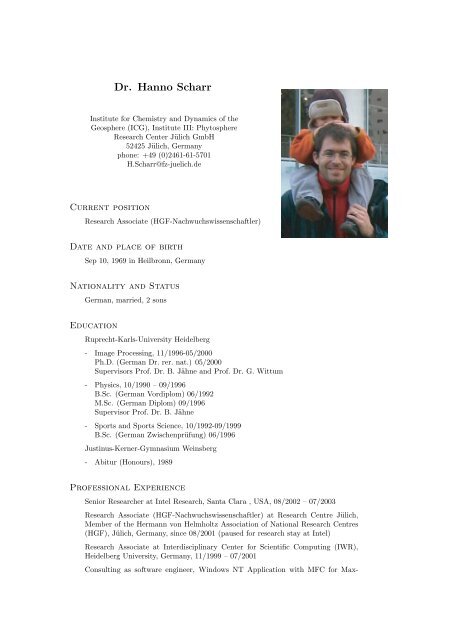
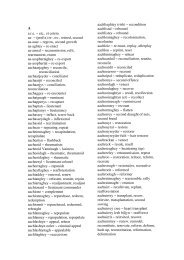
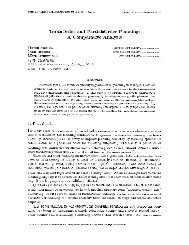
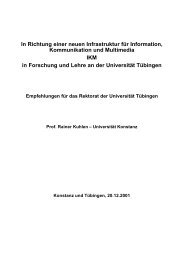
![arXiv:cs/0212044v1 [cs.DS] 16 Dec 2002](https://img.yumpu.com/21946154/1/190x245/arxivcs-0212044v1-csds-16-dec-2002.jpg?quality=85)
